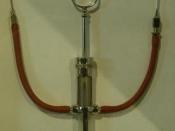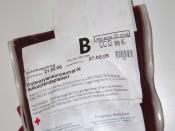A five-year old girl is riding down the street, on her way to her best friend's house. She doesn't have a care in the world and is quietly humming to herself. Suddenly a car whips around the corner and swerves to avoid the child, but he looses control and squarely hits the girl, causing the her to fall and get trapped between the car and her battered bicycle. A main artery in her leg has been severed and blood fills the gutter of the street. As she gets rushed to the hospital in the ambulance, a pint of blood is given to her to attempt to replace some of the life giving fluid that is pouring out of her leg. In the end she received four pints of blood and made a full recovery.
Although everything turned out all right for the girl, things could have been much different. What if that blood hadn't been there because the nation's blood supply was low? What if the blood that she received had been infected with a deadly disease such as Syphilis or HIV? These are pressing concerns for today's society.
Even though one in every five people will need a blood transfusion and the risk of contracting a disease such as AIDS is practically negligible, people are still concerned that the blood that they receive may have harmful or deadly diseases and that today's blood supply is not 'safe.'
However, 'safe' means different things for different people. For some, safe is an absolute security from any danger. This is an extreme viewpoint, though, because most people realize that one can never be completely safe. Another, and more popularly held connotation of 'safe,' is the probability of not getting hurt. This is a much more reasonable and plausible definition and therefor will...



BLOOD TRANSFUSION ESSAY WELL DONE
VERY GOOD WELL WRITTEN
1 out of 1 people found this comment useful.